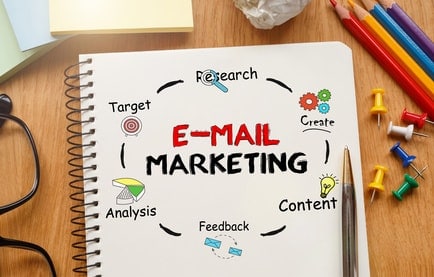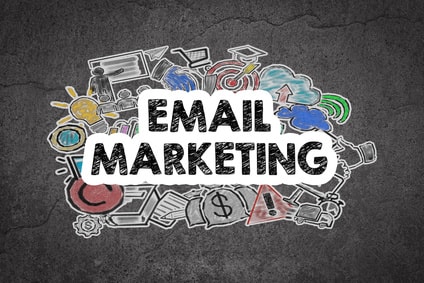Email marketing, is without a doubt, the most effective tool a marketer can use to obtain and retain customer loyalty. Think of it as getting direct access to your customer’s home to pitch your product or service. When everyone else is screaming for attention, you already have your hands in the client’s pocket.
According to the Radicati Group, approximately half of the worldwide population use email. That is close to 3.7 billion people! In the next two years, the number is expected to rise to 3.9 billion. So, how do you harness the power of email to drive more leads and bring home a slice of the pie?
By creating a solid email marketing campaign, of course!
In this guide, you’re going to learn how to create an email marketing campaign from scratch and keep your audience interested in what you have to say.
But first, a bit more on the utility of email as a marketing tool.
Why Email Marketing?
Email marketing is a vibrant and a very personal way to connect with your target customers. People are more likely to pay attention to your message if it’s in their inbox, sitting next to messages from their friends and family. 
Social media has become more of a noise with all those tweets, status updates, likes, comments, pouring in 24/7. Today, people are bombarded with pitches, advertisements, stealth promotions, and interruptions everywhere. Everywhere except the email inbox!
In a way, we can say that the inbox has become a place of virtual solitude that provides some relief from the chaos that is social media. Now, if you were given the chance to negotiate a deal either in a calm environment or amidst the hustle and bustle of the street: which one would you choose?
The answer is obvious!
PART I: The 6 step email marketing tutorial for beginners
- Sign up with a trustworthy email service provider.
To ensure that your email marketing strategy is based on a reliable, ethical foundation, you need to sign up with a reputable service provider. This will help you collect contacts, track them as necessary, and get in touch whenever you want. A reliable email service provider should be able to help you with the following functions:
- Manage the opt in and opt out process
- Provide email templates that are mobile friendly and easy to read
- Accurately track and report the open and click through rates, and even gather unsubscribe information.
- Can stay true to the laws and ethics that guide email
If you’re a beginner, there is no need to subscribe for a premium service just yet; MailChimp is an incredible email service provider that lets you perform all list building tasks up to your first 2,000 subscribers free of charge. However, be careful about posting affiliate links in your email. MailChimp does not allow affiliate links that take you to “make money or work from home” types of products. Generally if the link in your email takes them to your own site and if your page is not a blatant sales pitch for some dubious get-rich-quick schemes, you should be fine.
Check out this link to MailChimp’s rules concerning affiliate links.
As your list keeps on growing or if you want to just jump into a more professional campaign, you may need to try premium packages from another reputable provider.
Two of the best, that both will offer a free trial, are GetResponse and AWeber.
- Lay the bait
No one is going to join your email list just because you asked them to. Okay, maybe your friends and family will join, but they’re next to useless. Once you’ve signed up with an email service provider, you’ll have to add an opt-in form to your site and give away an exciting and useful incentive in exchange for the subscriber’s email address.
Don’t give up if your first incentive doesn’t get you any subscribers. You may need to experiment a little with different incentives until the right one comes along. The goal is to provide content that is so valuable that your potential subscribers won’t think twice before handing over their email ID to get it.
- Take action and get more people to join your email list.
Once the systems are in place, you can do either of these two things: rely on natural opt-ins coming from SEO traffic, or reach out to various sources to gain a bigger audience. Here are three things you can try to stay one step ahead of the game:
a) Guest Blogging: No, we aren’t talking about the average just blog that earns you a backlink to your website. We are talking about driving traffic back to your website from a guest blog by the use of a clever author bio and then capturing their email address through a landing page by offering a seductive incentive. Sounds like a lot of effort, but it works!
b) Get active on social media: hop on to various social media platforms like Facebook, Twitter, Instagram, etc. and promote your content. Any content, whether it is a blog or an article on your website or a guest blog that recently got published, is good enough for a start. Be active, answer people’s questions, and most importantly – provide value.
c) Conduct frequent webinars: unless you’re camera shy, webinars should be a steady part of your marketing efforts. People love to watch videos that provide value and help them to solve a problem. You’ve got to do exactly that! In addition to getting loads of traffic to your website, you see a spike in people opting for your mailing list when you are holding webinars. 
- Send valuable content to your subscribers frequently.
Getting people to sign up to your mailing list is half the battle won; the rest is about keeping them interested in what you have to say. As soon as you get subscribers, send them high quality content at least two times a week. Some may argue and say sending an email every day or every other day is fine, we think it is too pushy.
Besides, you can only have so much of valuable content to present. Combine the best of email content notifications and newsletters for maximum effect. Your goal should be to train your subscribers to consistently click on your links by regularly sending content that provide a ton of value.
You can also send custom selected content by using an autoresponder series. Start with two or three emails in the series and add more later on when needed. It’s always a good idea to have a stock of content ready to send out than brainstorm every other day.
- Present relevant offers to your subscribers without overdoing it.
Look, everyone wants to buy stuff but no one wants to be sold. While some email marketing experts advocate sending offers daily, we beg to differ. We are all about building solid relationships with our subscribers and presenting them relevant offers that actually solves a problem. We suggest that you take this approach too.
You can add relevant offers to your content notification emails or newsletters, or add sales emails to the autoresponder sequence. Many ways; a whole lot of different opinions! Be sure to include a strong call-to-action
button/link that encourages your subscriber to take action. And lastly, make sure the call-to-action links standout visually and are easily clickable.
- Eat, Sleep, Step 3-5, Repeat!
An effective email marketing strategy should be ever evolving, depending on the analysis, trends, and responses. This is not a set it and forget it action plan. To continually build your email list, publishing valuable content and sending relevant offers should be made a regular affair.
So, it makes sense to repeat the steps 3-5 with slight changes if needed. You should also be evaluating and re-evaluating your email marketing strategy to make sure everything is going smoothly. Review your offers, automated operations, welcome message, email open percentage, etc. to see if everything is working as expected.
The conclusion?
Your email list is one of your most valuable business assets, and you should treat it as such. In addition to building and strengthening your subscribers, you should always ensure that they get personalized, valuable information every time you send an email. We created this six step process to let you know that email marketing isn’t as complex as some make it to be.
PART II: Segment and personalize your email campaign
Personalization
No email marketing campaign can be successful if you do not send out personalized messages that speak to your audience’s hearts. You also need to segment your campaigns to cater to subscribers who only want to check out the relevant offers and those who want to read every update. Do the following things to personalize your email campaign:
- Signup personalization: Give your audience the option to choose what kind of emails they receive and be very clear about when they’ll receive it. Give them the choice to specify these during signup as it will help them to understand what exactly they are signing up for.
- Optimize unsubscribe process: people often unsubscribe when they feel like they’re receiving too many unsolicited emails. Find the perfect balance of quality and quantity to optimize your unsubscribe process, and you can maybe even convince them not to leave your mailing list.
Segmentation
Much like personalization, segmentation is all about categorizing your email list into more focused groups. Sending out emails to more targeted groups will give you a chance to observe the analytics and evaluate the performance post campaign. You’ll get a clear idea which groups get the most help from your emails.
You can segment a sizable email list through these kinds of subscriptions:
- Product updates
- Customers only list
- Daily email list
- Newsletter
- HTML for people who only prefer text only emails
PART III: How to analyze your post-campaign data
In a way, email marketing is a numbers game. The better you are with evaluating the numbers, the more probability of success you have in the future. After launching the email marketing campaign, collect the fresh, incoming data to measure its performance and create more successful marketing efforts later in the future. 
The things you need to keep an eye out on are the following:
- Open Rate
Simply speaking, open rate implies how many people open your email. If this rate is dangerously low, you may need to revise your campaign logistics to get through people’s spam filters and grab their attention. Begin by editing your subject line with text that instantly catches your audience’s attention.
There is no point in sending emails if your recipient doesn’t open them. It is only after opening the email will they be able to follow along your call-to-action.
- CTR (Click-through-rate)
CRT shows the percentage of people who opened your email and followed through the call-to-action plan that was suggested. This metric can give you key insights into subscriber behavior that may help you in reformatting and creating a better plan for future campaigns. You can also compare to email campaigns and see which one did better and figure out the reason why.
- Lead Generation
The data you collect from a campaign can be of tremendous help in generating future leads. Find out and analyze the success of how the users received personalized experiences to zero in on more laser focused campaigns in the future.
- Bounce Rate
Bounces can be classified into two categories: hard bounces and soft bounces. Hard bounces are when your subscribers email is inactive or have become invalid in some way. For example, the person may have mistakenly entered the wrong email address, someone may have changed their email, or if it doesn’t exist.
Soft bounces happen when your email fails to land in your subscriber’s inbox because it might be temporarily full or for any other reason. To optimize your bounce rates, include a short paragraph on every email and remind the customers to keep you informed if they change their contact details so that you can stay in touch.
The best way to get started?
Look, email marketing might not be the toughest job in the universe; but it still has a steep learning curve. If this is the first time you read about email marketing, then the information right here might be difficult to consume all at once. You can bookmark this page and always come back later.
As far as getting started is concerned, go ahead and sign up on MailChimp; this service lets you collect up to 1000 subscribers for free. You may also check out paid options like Aweber and GetResponse that provide a host of email marketing tools to better collect, manage, and engage your subscribers.
As you grow your email list, you’ll automatically figure things out about what practices work best for your audience.
A Final Word
Starting your email campaign is a very important tool for your online enterprize, but it is not much use if you haven’t got your affiliate marketing business started and beginning to draw traffic. If you want to know how to to all this and everything about affiliate marketing, then take a look at the program I use. It is absolutely free to try out, no time limit for the free trial (which includes two websites by the way) and what is more, you do not need a credit card – just an email address.
************